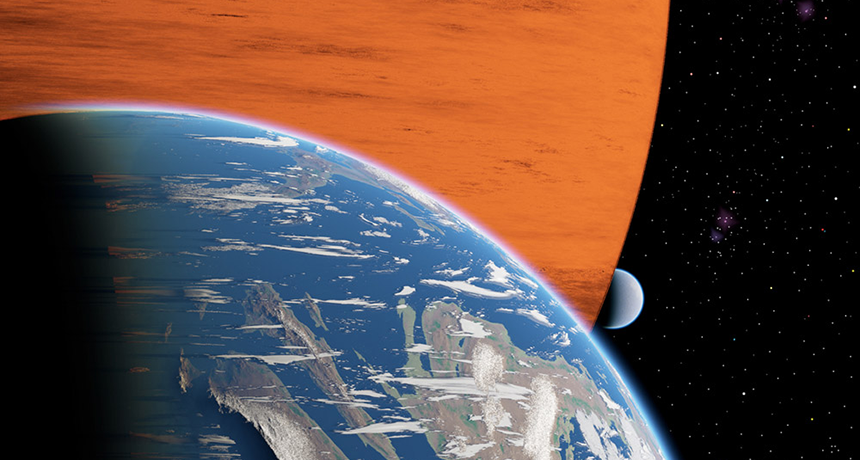Home on the moon
Astronomers say rocky moons orbiting distant planets might support alien life

Life on the moon — but not ours. This illustration shows two large moons orbiting a giant, gassy planet (in orange). Astronomers say the right type of moon could harbor alien life.
R. HELLER, AIP
The first confirmation of alien life might come not from a distant planet, but from a far-flung moon.
Planet hunters have identified hundreds of exoplanets, or planets outside our solar system. So far, none seem to support life as we know it. Most of those worlds are too big and too hot; some are too cold. But many would likely have moons. And just the right moon could be a cradle of alien life, concludes a pair of astronomers.
René Heller of the Leibniz Institute for Astrophysics in Potsdam, Germany, and Rory Barnes of the University of Washington in Seattle created a checklist of what would make a moon livable. They published the list in the January Astrobiology. No exomoons have been found yet. But when they are, the checklist will help identify which ones E.T. might call home.
A livable moon would receive light and heat from both the nearest star and the planet the moon orbits. It can’t be too close to the planet, however, or it will get too hot. The moon would have to be rocky and able to hold liquid water. And it would need to be about as massive as Earth. The moon would also need a magnetic field to help shield it against harmful radiation.
That’s a tall order. Astronomers do not yet know of such a massive moon. The largest in our solar system is Jupiter’s moon Ganymede. It would take about 40 Ganymedes to equal the mass of Earth. But just because such a heavyweight has never been seen doesn’t mean it can’t exist: Scientists now suspect that our galaxy hosts hundreds of billions of exoplanets.
Some of those distant worlds are fairly exotic. In November, one team of astronomers described a planet that appeared to be made of diamonds. Last July, others introduced an exoplanet smaller than Earth and believed to be covered in molten lava. The galactic neighborhood still surprises astronomers, and Heller told Science News he thinks a habitable moon is a real possibility.
“When I think of all the weird planets we’ve found — hot Jupiters, planets orbiting two stars — why shouldn’t we be able to find a large moon?” he asks.
“I’m encouraged by the paper that we’ll find exomoons in abundance and that a fraction of them could be habitable,” Darren Williams told Science News. An astronomer at Penn State University in Erie, he was not involved in creating the new checklist.
Unfortunately, adds Penn State planetary scientist James Kasting, current technology won’t allow scientists to identify life on exomoons. Today’s telescopes lack the ability to determine the presence of water, carbon dioxide or other signatures of life on exomoons. “You can postulate that habitable moons are out there, but you’ll never be able to check it,” he says — at least not for a while.
Power Words
habitable A place suitable for humans or other living things to comfortably dwell.
hot Jupiter A type of gas exoplanet that’s about as large as Jupiter.
exomoon A moon that orbits an exoplanet.
exoplanet A planet outside the solar system.
astrophysics The study of the physical nature of stars, galaxies and other bodies in the universe.
magnetic field A region around a magnetic material where the force of magnetism acts.







